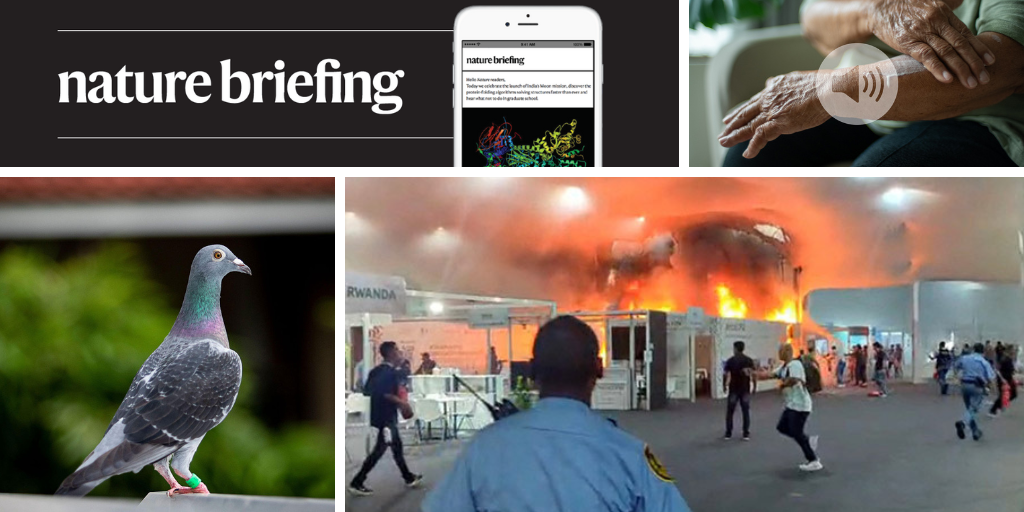You have full access to this article via your institution.
Hello Nature readers, would you like to get this Briefing in your inbox free every day? Sign up here.

Credit: Suriya Silsaksom/Alamy
Pigeons (Columba livia) seem to be able to sense magnetic fields by detecting tiny electrical currents in their inner ears. Researchers performed advanced brain mapping as well single-cell RNA sequencing of pigeon inner-ear cells. Both lines of evidence point to the inner ear as the birds’ ‘magnetoreception’ organ. Such an organ gives the birds an ‘inner compass’ that could help to explain their navigational nous over long distances. “This is probably the clearest demonstration of the neural pathways responsible for magnetic processing in any animal,” says sensory biology researcher Eric Warrant.
Neurotechnology developed Paradromics has received approval from the US Food and Drug Administration to begin a long-term clinical trial of its brain-computer interface (BCI). The company — a rival to billionaire entrepreneur Elon Musk’s Neuralink — will implant its device in two volunteers who were left unable to speak owing to neurological diseases and injuries. The trial aims to determine whether the device is safe, and can restore a person’s ability to communicate with real-time speech — the first BCI clinical trial to formally target synthetic-voice generation.
On the last scheduled day of the UN climate conference (COP30), dozens of nations have committed to block any agreement that does not include a plan for how to transition away from fossil fuels, as agreed at COP28 in 2023. But the latest draft text from the conference contains no mention of such a phase-out. A group that includes petrostates such as Saudi Arabia and Russia are opposed to ending the fossil fuel era. The Brazilian president of COP30, André Corrêa do Lago, urged negotiators to channel the spirit of consensus that helped them to create the transformational Paris Agreement at COP21. “If we don’t strengthen this, everybody will lose.”

Talks at COP30 were disrupted for several hours by a fire on Thursday. (AFPTV/AFP via Getty)
Features & opinion
The Global Microbiome Conservancy’s workspace has been nicknamed the “smelly lab” — and you can imagine why: the lab works with stool samples from all over the world to investigate the human gut. “It’s a little bit gross, but that’s just our best way to access this incredible and important biodiversity,” says researcher Mathieu Groussin. Faeces are also being investigated as a source of treatments for tenacious Clostridium difficile infections, obesity, type 2 diabetes, Parkinson’s disease and other conditions. Others are researching using urine as fertilizer.
In 2023, one of the world’s most significant libraries was hit with a cyber attack that destroyed multiple systems, requiring that its entire technology infrastructure be rebuilt and costing millions. Staff at the British Library say that the attack undermined the working environment, and more than 300 are on strike. The Library’s chief executive has resigned, less than a year after she took the position. And some material is still not available to scholars. “Libraries and archives are the labs of humanities and social science scholars, and history is not possible without them,” argues Hetan Shah, the chief executive of The British Academy. “The nation rightly values scientific infrastructure, but it pays extraordinarily little attention to what is happening at our national library.”
Museums Journal | 3 min read & City AM | 4 min read
Four travellers become one in The singular proposition of trees and two people push back against infinite growth in How to defuse a time bomb.
Nature | 5 min read & Nature | 6 min read
Researchers have developed a skin-permeable polymer that can deliver insulin into the body, which they say could one day offer an alternative to injections for diabetes management. In lab tests, insulin attached to the polymer was able to penetrate through the skin’s layers without causing damage and reduce blood glucose levels in animal models for diabetes at a comparable speed to injected insulin.
Nature Podcast | 42 min listen
Subscribe to the Nature Podcast on Apple Podcasts, Spotify or YouTube Music, or use the RSS feed.
In this week’s penguin-seeking puzzle, Leif Penguinson is exploring the green lagoon in Timanfaya National Park in Lanzarote, Spain. Can you find the penguin?
The answer will be in Monday’s e-mail, all thanks to Briefing photo editor and penguin wrangler Tom Houghton.
This newsletter is always evolving — tell us what you think! Please send your feedback to [email protected].
Thanks for reading,
Flora Graham, senior editor, Nature Briefing
With contributions by Jacob Smith
• Nature Briefing: Careers — insights, advice and award-winning journalism to help you optimize your working life
• Nature Briefing: Microbiology — the most abundant living entities on our planet — microorganisms — and the role they play in health, the environment and food systems
• Nature Briefing: Anthropocene — climate change, biodiversity, sustainability and geoengineering
• Nature Briefing: AI & Robotics — 100% written by humans, of course
• Nature Briefing: Cancer — a weekly newsletter written with cancer researchers in mind
• Nature Briefing: Translational Research — covers biotechnology, drug discovery and pharma


